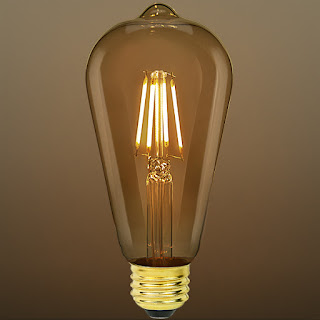 |
| The Welsbach gas mantle was the most advanced type of lighting fixture through most of the Victorian era. |
Although nowadays it’s hard to imagine a world without electric lighting, it's been with us for a relative wink of an eye. Thomas Edison perfected his incandescent bulb in 1879, after trying out hundreds of filament materials ranging from bamboo to hair to paper (he finally settled on tungsten). Not so well known is that Edison also had to invent a way to evacuate the air from the bulbs--no mean task using Victorian technology.
 |
| Thomas Edison and the light bulb he perfected in 1879. Others had pioneered the idea of electric lighting, but Edison made it practical. |
In the early days of electric lighting, fixtures intentionally flaunted naked bulbs so that no one could possibly mistake them for gas. It was a way for people to advertise their modernity, much as hipsters of the 1990s sported conspicuous cell phone antennas on their cars.
 |
| The first neon sign in the U.S. was a Packard automobile advertising sign, circa 1924, similar to this one. |
The first really new development in lighting since Edison’s light bulb was neon tubing, which made a big splash in the early 1930s. It made its American debut in a sign for a Packard showroom, and was soon all the rage as signage in movie theaters and other commercial buildings. However, with its otherworldly glow, it found little use in residential design.
 |
| Fluorescent lighting was the height of modernity from the 1940s all the way through the 1970s, despite suspicions about its negative effects on behavior. |
In the interim, a number of other high-efficiency lighting types have been developed, including mercury vapor, sodium vapor, and metal halide, but the unnatural spectrum of light they produce has also precluded their use in domestic work.
By contrast, halogen residential lighting, introduced during the 80s, was an instant hit with the public. Why? Halogen’s warm, yellow-white light is very close to the spectrum of sunlight. Accordingly, engineers are currently working hard to make the current generation of high efficiency lighting—LEDs, for "light emitting diodes"—as warm and friendly as incandescent and halogen lamps.
Because the sun, after all, is still everyone’s favorite lighting fixture.

No comments:
Post a Comment